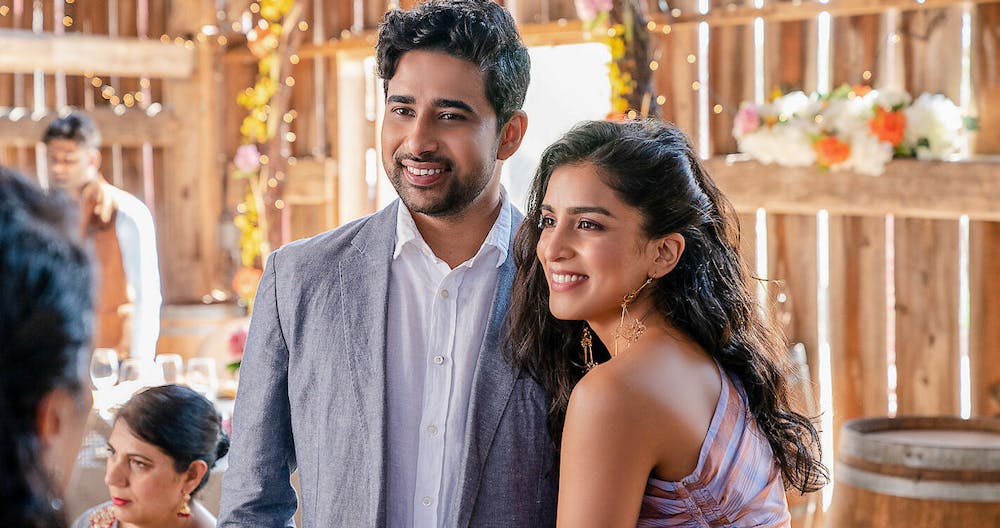Netflix has made recent efforts to increase Indian representation in its content with the third season of Mindy Kaling’s teen dramedy “Never Have I Ever” and the second season of the infamous reality series “Indian Matchmaking” both hitting the streaming service last month. But, representation for representation’s sake falls flat. Just look at Netflix's newest romantic comedy featuring Indian or Indian-American characters, “Wedding Season.”
“Wedding Season” features Pallavi Sharda as Asha and Suraj Sharma as Ravi. In order to evade the pressure from their parents to get married, as well as the gossip of the “Indian aunties,” Asha and Ravi pretend to be in a relationship through wedding season — predictably, they end up actually falling for each other, but equally predictably, there’s a minor conflict which they quickly resolve just in time for the happily ever after.
It is not new or inventive, but that’s not the problem with it — predictability is not only expected of the romantic comedy genre, but it can actually be comforting. If the movie leaned into its predictability, it would be far easier to mindlessly enjoy — instead it tries to be unique, and it turns to the “Indian-ness” to bring the novelty factor. Maybe that’s why it was hard to shake the distinct impression that this film, while clearly marketing itself on the basis of diversity, was primarily made for a Western audience.
Rom-coms rely on caricatures and tropes — this one is full of them, with Asha embodying the workaholic who is reluctantly edged into romance. But when this extends to cultural tropes the way it does in “Wedding Season,” it becomes a little harder to forgive. The gossiping aunties at the weddings, for instance, are almost painful to watch. Indian families are generally large, and it is true that relatives often are not shy about sharing their opinions. But instead of exploring the genuine complexities in family dynamics and “boundaries” within the Indian joint family, the film adopts a one-dimensional Western gaze. The frustration of dealing with judgment from an entire extended family is a valid, lived experience. But what a Western audience might presumptuously deem “boundary-crossing” is usually accompanied by layers of genuine affection and closeness that the movie conveniently ignores. The stereotypes about overbearing relatives and parents are exploited in such bad taste that what could have been good-natured jokes or insightful commentaries are turned into a cringe-worthy ridicule of age-old social structures.
It is true that the cast is Indian, and the screenwriter Shiwani Srivastava is Indian-American. While it is easy to end the conversation there, the tendency to assume that if the writer is Indian the portrayal of the culture is automatically authentic makes the cycle even more dangerous. If anything, this proves that while representation is important, it is not enough.
Effective representation goes beyond the ethnicity of the cast and writers — it is also about the cultural reference point and the audience, among other things. Because “Wedding Season” is clearly not written for an Indian audience, it also faces the problem of holding Western culture as its reference point, and the Indian culture as mere deviations from the norm. Asha struggles to wear a Sari and wonders how “half a billion women wear these things,” for instance, and her father humorously claims that “Asha is always saying our thinking is stuck in the India of 40 years ago.”
While “Wedding Season” probably intended to provide insight into the Indian-American experience of assimilating while also carrying on traditions, it fails so astoundingly that its characters feed right into the trope of “ABCD”s — American Born Confused Desis. Asha and her sister Priya show little remorse for the cultural cost of their “modernity.” While comforting Priya about her concerns of being the first in the family to marry a man who is not Indian, Asha says Priya’s fiance “Nick is way more Indian than we are.”
Throughout the movie, Nick — a white man — tries to delve head-first into Indian culture against Priya’s wishes. He tries to learn Bollywood dances, humorously fumbles through Hindi and makes Masala Mojitos. Asha’s comment would ring true if the attempts weren’t so superficial, which also reflects on how superficial her view and understanding of Indian culture is.
Even at the movie’s “heartfelt” turning-point, when Asha makes an important presentation that lands her a promotion, the movie’s attempt at poignancy falls short. To make her case, she shares her own personal story — about how her parents sacrificed everything to cross the shores “to make sure their children had a better life.” However, this story falsely propagates the idea that staying in India inherently implies an inferior quality of life, that being born in India is something to overcome and escape. Once again, India is considered only through the lens of the idealized West.
Even as a guilty pleasure, “Wedding Season” is frustrating to watch as an Indian consumer — but the real danger is in how perfectly entertaining, amusing or “hate-watchable” it is for Western audiences who lack context, and who form impressions based on this media and others like it. The Western lens through which “Wedding Season” depicts Indian culture will only reinforce the distorted Western gaze further, creating a cycle of bias and caricaturing.
Again and again, “Wedding Season” insists on playing the representation card, and each time it ends up losing tragically.





